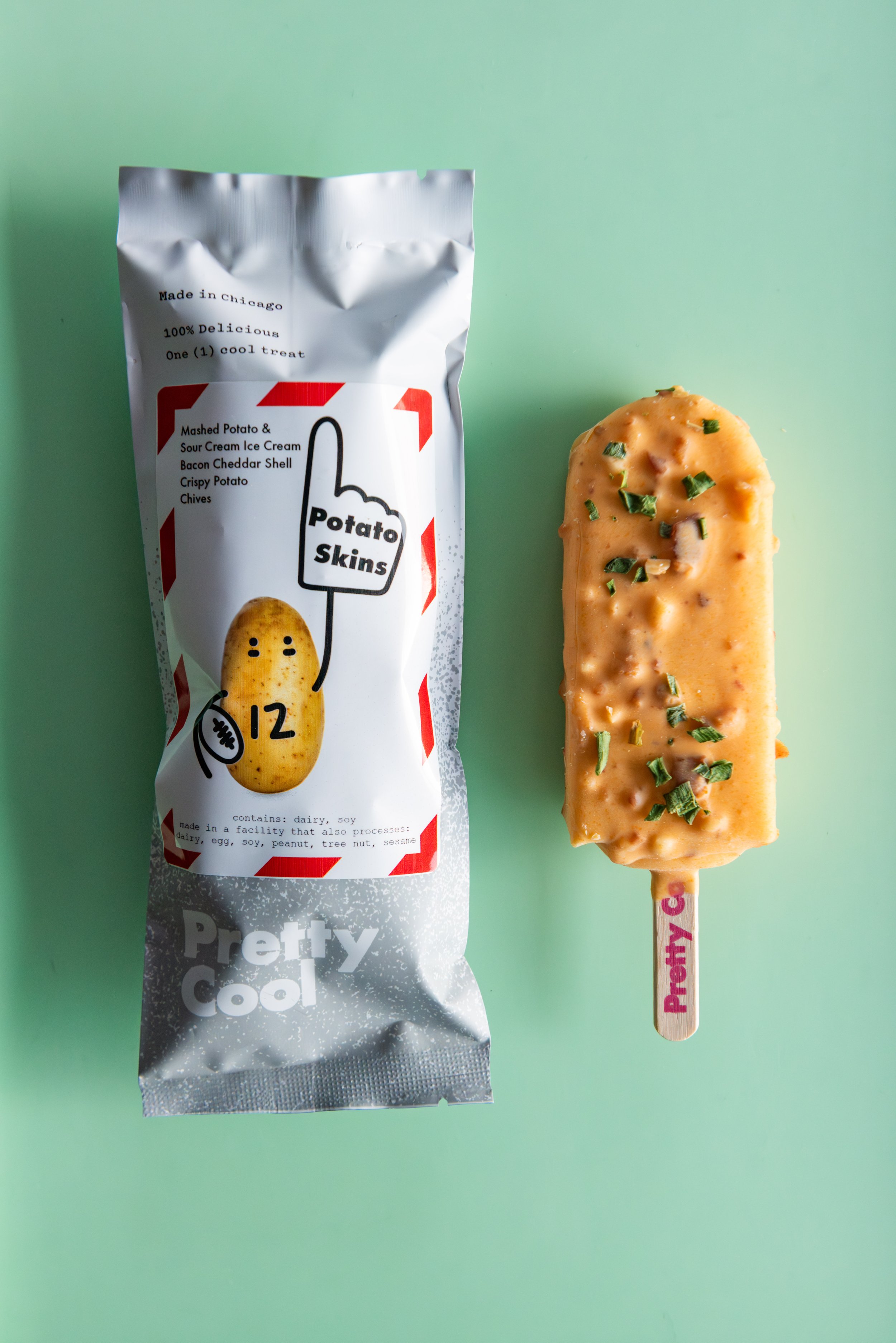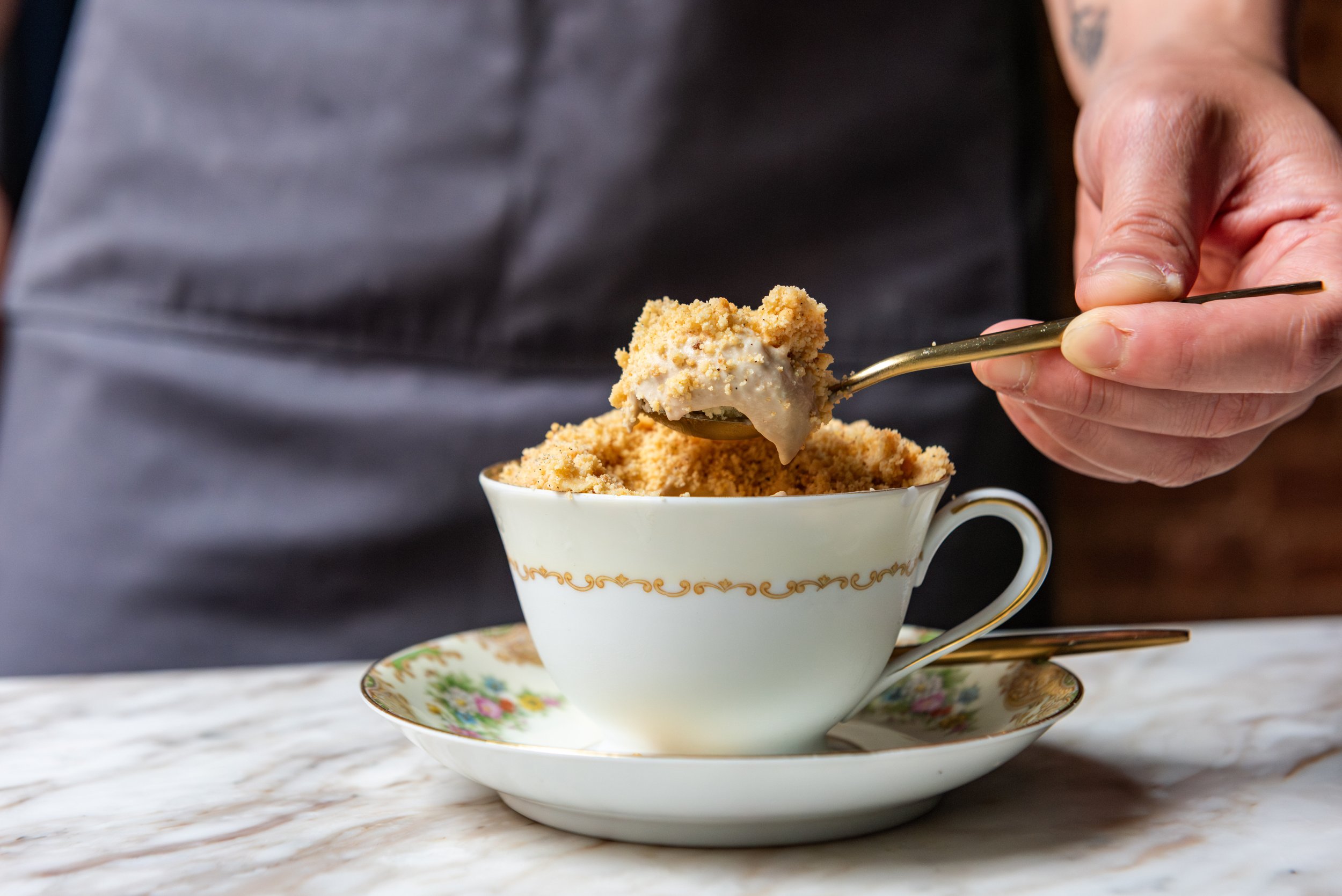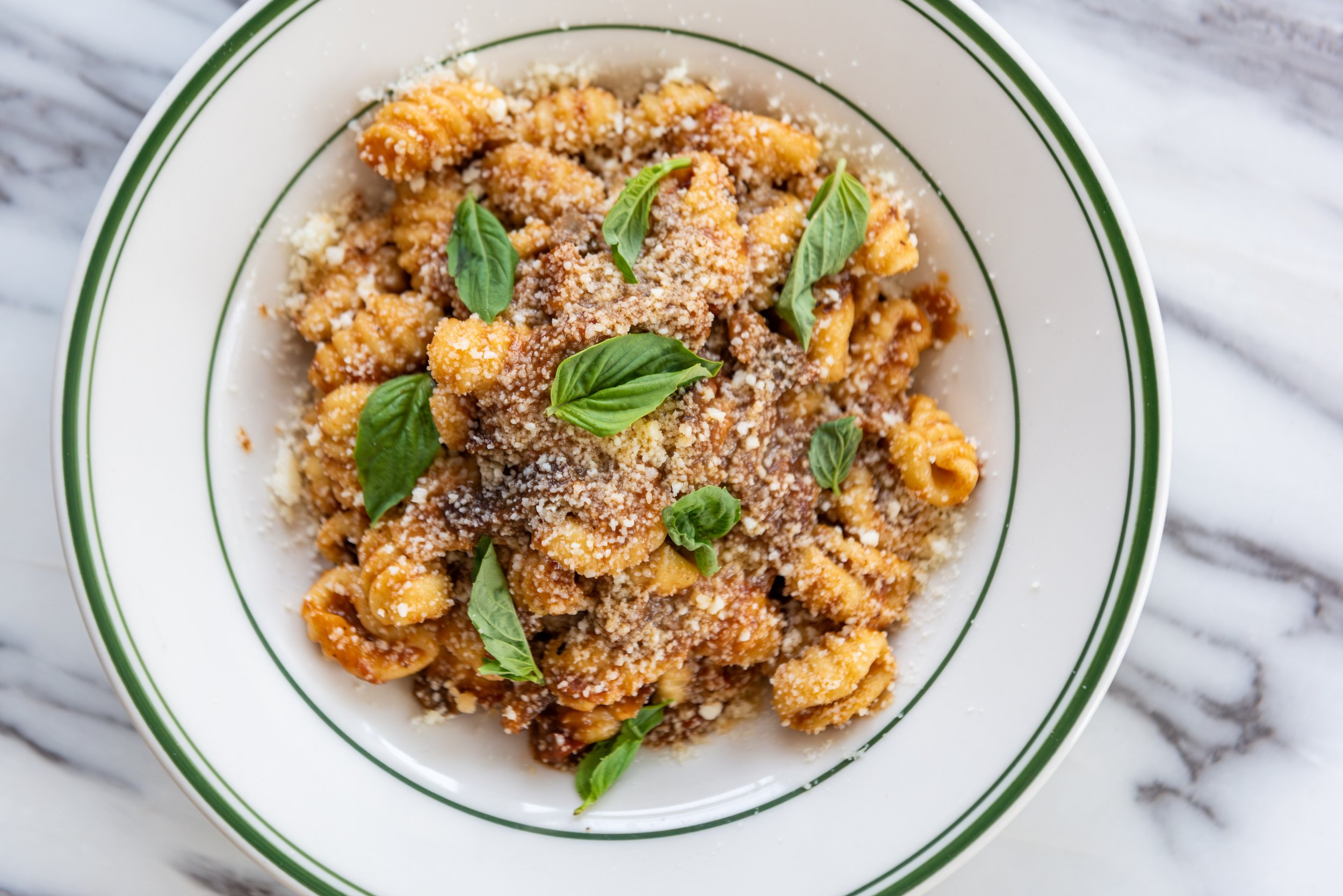Chicago Kitchen Notebook
An in-depth look at some of our favorite dishes and cocktails from our time on the ground in Chicago.
Potato skins ice cream bar
As pastry chef of Pretty Cool Ice Cream, Alana Gidycz inherited the shop’s cold weather tradition: creating an annual novelty ice cream bar inspired by classic Thanksgiving sides and Super Bowl snacks. Past flavors have included jalapeño poppers, walking tacos, and green bean casserole, but this past holiday season, she chose potato skins as the catalyst for her newest bar. Gidycz starts by incorporating sour cream and salt into her tried-and-true ice cream base. She then adds boxed mashed potato flakes to enhance the potato flavor without compromising the smooth consistency. For the ice cream bar’s crunchy shell, she combines neon orange cheese powder, white chocolate, and cocoa butter before folding in crumbled bacon. After dipping the frozen bars into the savory exterior, she coats the bar in freeze-dried chive “sprinkles,” adding a touch of onion-flavored nostalgia to the treat. Gidycz says, “It tastes like a very cold twice baked potato.” This beloved tradition (and challenge) has given Gidycz the inspiration and creative license to continue making unexpected savory flavors, and guests are eager to try them. “[Ice cream] allows for so much creativity even though it's just the one medium we work with. It's all meant to be fun, and I think doing savory flavors is just silly and a good time.”
Pillow Talk
Global flavors—from the Philippines to the UK—intertwine to create the dynamic menu at Valhalla. Behind the bar, Bartender Sammy Faze pulls inspiration from the kitchen, especially when curating cocktails for the tasting menu’s “Anything But Wine” pairings. So when he saw a Scotch lamb dish on the menu, he wanted to create a cocktail that would pair with it seamlessly. “I saw that Chef Stephen [Gillanders] had put a sort of tikka masala sauce on the side,” says Faze, “so I wanted to use more Indian ingredients [for the cocktail].” Faze begins by creating a syrup, toasting cumin and fennel seeds before adding Syrah and sugar and cooking it down. “I talked with [Sommelier] Jelena Prodan about classic lamb pairings, and she had a spare, affordable bottle [of Syrah].” For the base of the cocktail, Faze decided on a lowerproof option: Mizu green tea shōchū. “It’s a bit softer, more delicate and nuanced. I thought that the green tea element would play an interesting role with the syrup.” Doubling down on the Indian flavors, Faze wanted to evoke a lassi, trying out yogurt and cream, but finally settling on whole milk and coconut water for a velvety mouthfeel. Lastly, for a touch of tartness without using fresh citrus, Faze finishes the cocktail with a dash of citric acid. The final drink is an aromatic, textural cocktail driven by collaboration between front and back of house. “I feel very fortunate to be inspired by the creativity around me.”
vietnamese duck wings
At After, the luxe restaurant and cocktail lounge from Chef Curtis Duff y, Chef de Cuisine Joe Mishler wanted to incorporate some more casual bar staples onto the menu. Tapping into his love of Asian flavors, he decided on crispy, decadent Vietnamese-inspired duck wings. “What's more approachable than wings at a bar?” From the sauce to the batter, the deceptively simple dish took weeks to get right. Mishler first cures the wings in a mixture of salt, sugar, and garlic before rinsing off the cure and braising them in duck fat for 10 hours. “You get that perfect tenderness without them completely falling apart.” Next comes the batter, which took Mishler over 100 attempts to figure out. “I got my hands on every flour I could. I tried a dry mix, wet batter, a combination of both." He eventually settled on a mixture of rice flour, cornstarch, and a splash of water for an extra crispy, “non-glutinous” coating. After a quick fry, the wings are dipped in a sweet and savory caramel sauce. Inspired by the Vietnamese caramel technique, or nước màu, Mishler creates a deep amber caramel and seasons it with toasted garlic, lime zest, lime juice, fish sauce, and black pepper. The wings, garnished with scallion, cilantro, and mint, have quickly become a customer favorite. “I love seeing the guests’ reactions, and I love teaching the technique to my cooks.”
Dinuguan
Dinuguan isn’t anything new, but for Chef Joe Fontelera it’s an opportunity to change people's perceptions and expand their palates. “When I was growing up, very few people outside of the Filipino community had heard of it,” he says. “Why don't more people eat this? They eat blood pudding and blood sausage, why not blood stew?” At his restaurant, Boonie’s, the traditional dish has become a staple on the menu. He starts by braising cubed pork belly with onions, ginger, garlic, chiles, tamarind, and lemongrass, as well as fish sauce and dark brown cane sugar. Separately, Fontelera mixes pork blood with vinegar. It’s “a technique my grandma taught me. If you put the blood right in, it will break and coagulate, but if you put vinegar in before and temper it, you will have a much smoother sauce, and lose the iron and gaminess.” The mixture is added to the braise and cooked until the blood has thickened. Traditionally, dinuguan is served with siling haba, a long chile common in the Philippines, but “nobody ever eats that,” jokes Fontelera. Instead, he garnishes the stew with blistered shishito peppers, paying homage to the original while adding a craveable, modern touch. “A big part of Boonie’s is making space for Filipino food that isn't often seen,” he says. “I want our food and culture to breathe and grow in the way other foods have been allowed to in American culture, while still being identifiable.”
fried pickles
While building their condiment business, Pickled Prince, Chefs Brian Greene and Alex Skrzypczyk did extensive research. They sampled pickles all around Chicago and traveled to Poland with Skrzypczyk’s family to taste even more, but when they set out to make a sour pickle that was unique and true to their Chicago roots, Greene decided to try something unconventional. He recycled the brine used to ferment their house giardiniera and submerged a batch of cucumbers in it. The experiment was a success. The brine “retains all the flavor of the garlic and chile and the sweetness of the carrots and peppers. It adds a lot to the fermentation process” and flavor of the pickles. For their fried pickle dish, Greene and Skrzypczyk broke with tradition again. They were “talking about how with the spear the breading falls off, but the chips get too soggy.” So, to keep them crispy and cohesive, Greene and Skrzypczyk cut the sour pickles hot dog octopus-style for “max surface area and max crunch.” The fermented sour pickles are dredged in seasoned flour, coated in a buttermilk-hot sauce mixture, and covered in panko breadcrumbs before they are fried and served alongside a lemon-dill dipping sauce. Greene and Skrzypczyk’s fried pickles are whimsical, lighthearted, and bursting with sweet, acidic, and aromatic flavors. They are also a way for the couple to “think outside the jar” and highlight their specialty ferments in a composed, eye-catching way.
fermented banana custard
Emerging from a typical Chicago winter—short on seasonal fruit and craving freshness—Pastry Chef Jenna Pegg sought out a flexible fruit option for a new dessert for the tasting menu at Smyth. “Chef [John Shields] had always been interested in making a banana mold. So, I specifically ordered super hard green bananas so I could make one.” Once Pegg had her custom silicone mold, fulfilling the visual aspect of the dish led her to fermented banana custard. She fermented the bananas for a month (“just let them sit on their own”) before blending the fermented banana oil into a “basic, low-level egg custard base.” To complement the rich fruit flavor, Pegg incorporated a few savory elements. “Smyth is always using pine (or any conifer) as an ingredient throughout the menu. Also, kombu. In my three-year tenure here, there are only a small handful of dishes that haven’t touched kombu.” The pine came by way of baby pine cones that the Smyth team foraged around the city, soaked in a rich simple syrup, and dehydrated until light and crisp. Pegg braised the kombu in pineberry syrup to enhance the sweetness before laying pieces over the banana-shaped custard to mimic its skin. Lastly, the custard was plated atop a swath of pine nut purée, adorned with a few pieces of pickled black walnut, and served with a pipette of fermented banana oil, black walnut oil, and banana vinegar for a final boost of flavor.











